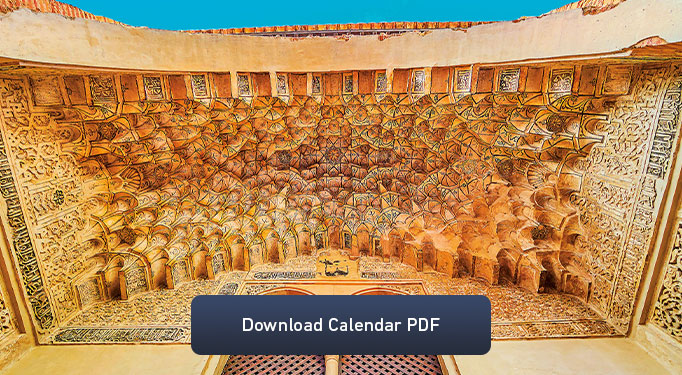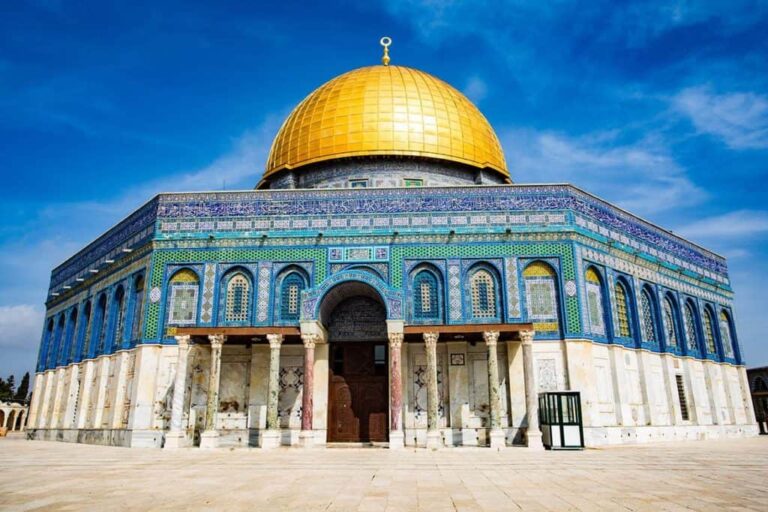Delving into the intricacies of Islam, one might ponder: what event marks the beginning of the Islamic calendar? This enigmatic query has intrigued scholars and the faithful alike for centuries. The Islamic calendar, also known as the Hijri calendar, commences with a significant event in Islamic history, a pivotal moment that defined the faith’s trajectory. Revisiting the origins of this calendar sheds light on the foundational principles of Islam and the cultural significance of timekeeping. Join us on a journey of discovery as we unravel the mystery behind the inception of the Islamic calendar, potentially unveiling a deeper understanding of Islamic traditions and beliefs.
Introduction: Understanding the Islamic Calendar
The Islamic calendar, also known as the Hijri calendar, is a lunar calendar used by Muslims worldwide. It consists of 12 months based on the phases of the moon, making it shorter than the Gregorian calendar. The starting point of the Islamic calendar dates back to a significant event in Islamic history.
Origin of the Islamic Calendar
The Islamic calendar begins with the migration of Prophet Muhammad (PBUH) from Mecca to Medina in 622 CE. This event, known as the Hijra, marks the beginning of the Islamic lunar calendar. The year of this migration is considered year 1 in the Islamic calendar.
Structure of the Islamic Calendar
The Islamic calendar follows a lunar system, where each month starts with the sighting of the new moon. It consists of either 29 or 30 days, amounting to a total of 354 or 355 days in a year. As a result, Islamic months do not align with the seasons as in the Gregorian calendar.

Historical Background of the Islamic Calendar
The Islamic calendar, also known as the Hijri calendar, is a lunar calendar consisting of 12 months in a year of 354 or 355 days. It began in AD 622, the year of the Hijra, the migration of Prophet Muhammad from Mecca to Medina. This event marked the beginning of the Islamic era and the calendar is used by Muslims worldwide to determine the dates of religious observances.
The Hijra – A Turning Point
The significance of the Hijra lies in its role as the starting point of the Islamic calendar, emphasizing the importance of the event in Islamic history. The year of the migration was chosen as the base year for the calendar, establishing a new era for Muslims.
It marked the transition from a period of difficulty and persecution in Mecca to a new beginning in Medina, where Islam could flourish and grow stronger.
The Lunar Calendar System
The Islamic calendar is based on the phases of the moon, making each month 29 or 30 days long. This differs from the solar Gregorian calendar, resulting in the Islamic year being shorter.
- The lunar calendar follows the cycle of the moon, with months starting when the first crescent of a new moon is sighted.
- This system requires Muslims to observe religious events and festivals based on the sighting of the moon, adding a unique aspect to their calendar.
Significance of the Hijrah in Islam
The Hijrah marks the beginning of the Islamic calendar (\2021) and holds immense importance in Islamic history. It refers to Prophet Muhammad’s migration from Mecca to Medina in 622 AD.
Impact on Islamic Calendar
The event of Hijrah was so significant that it was chosen as the starting point for the Islamic calendar. This event symbolizes a new era for Muslims worldwide.
Transformation of Muslim Community
After the Hijrah, there was a shift in power as Islam began to flourish in Medina, leading to the establishment of the first Islamic state. The community grew stronger and more unified.
- The bond among the Muslims strengthened
- Islamic principles were implemented
- New laws were established
The Event of Hijrah: Migration of Prophet Muhammad
The event of Hijrah marks the beginning of the Islamic calendar. It refers to the migration of Prophet Muhammad and his followers from Mecca to Medina in 622 CE.
Significance of Hijrah
Hijrah holds profound significance in Islamic history as it symbolizes the establishment of the first Islamic state and the spread of Islam.
Impact on the Islamic Calendar
The migration of Prophet Muhammad led to the initiation of the Islamic lunar calendar, which began with the month of Muharram in the year of migration.
The Islamic calendar is based on the lunar cycle, consisting of 12 months in a year, with each month being either 29 or 30 days.
Establishment of the Islamic Calendar
The Islamic calendar, also known as the Hijri calendar, began with the Hijra (migration) of the Islamic prophet Muhammad and his followers from Mecca to Medina in 622 AD. This event marks the starting point of the Islamic calendar, which is lunar-based and consists of 12 months in a year of 354 or 355 days.
Significance of the Hijra
The Hijra not only marked a significant event in Islamic history but also symbolized the establishment of a new community and the beginning of an Islamic state in Medina.
Structure of the Islamic Calendar
The Islamic calendar follows a 12-month lunar system, with each month starting based on the sighting of the new moon. This results in the Islamic year being shorter than the Gregorian calendar. The lunar year is divided into 12 months, with the beginning of each month determined by the visibility of the crescent moon.
Comparison with the Gregorian Calendar
When considering what event marks the beginning of the Islamic calendar, it’s interesting to look at how it compares to the Gregorian calendar. The Islamic calendar is a lunar calendar consisting of 12 months in a year of 354 or 355 days, while the Gregorian calendar is a solar calendar with 12 months in a year of 365 days, except in leap years when a day is added.
Months and Year Length
The Islamic calendar is shorter than the Gregorian calendar by about 10 to 12 days each year. This difference in year length means that Islamic months rotate through the seasons over a 33-year cycle, unlike in the Gregorian calendar where months are fixed to seasons.
Origin and Based Year
The Islamic calendar starts from the migration of Prophet Muhammad from Mecca to Medina, known as the Hijrah in the year 622 CE. On the other hand, the Gregorian calendar is based on the estimated birth year of Jesus Christ. This creates a difference in the starting point and the year numbering system between the two calendars.
Impact of the Hijrah on Islamic History
The Hijrah, the migration of Prophet Muhammad from Mecca to Medina in 622 CE, marks the beginning of the Islamic calendar. This event holds immense importance in Islamic history, signifying a new era for Muslims.
Transformation of Society
The Hijrah brought about a transformative period for Islamic society. It shifted the center of Islamic authority from Mecca to Medina, establishing a new social order and governance.
This exodus was crucial for Islam’s survival, enabling the community to thrive and grow in the face of persecution.
Solidifying Faith
The Hijrah strengthened the faith of early Muslims, testing their commitment and resolve to follow the teachings of Islam despite the challenges they faced.
- The struggles faced during the migration forged a stronger bond among Muslims, fostering unity and solidarity.
- It laid the foundation for the establishment of the first Islamic state in Medina, setting a precedent for governance based on Islamic principles.
Frequently Asked Questions
-
- What event marks the beginning of the Islamic calendar?
- The beginning of the Islamic calendar is marked by the migration (Hijra) of Prophet Muhammad from Mecca to Medina in 622 AD.
-
- Why is the Hijra considered significant for the Islamic calendar?
- The Hijra is considered significant because it not only symbolizes a physical journey but also signifies a new era for Muslims, where they established a community based on Islamic principles and teachings.
-
- How is the Islamic calendar different from the Gregorian calendar?
- The Islamic calendar is based on lunar cycles, while the Gregorian calendar follows solar cycles. The Islamic calendar is shorter, with 354 or 355 days, compared to the Gregorian calendar’s 365 or 366 days.
-
- What is the first month of the Islamic calendar and why is it significant?
- Muharram is the first month of the Islamic calendar, and it is significant because of the Ashura fasting and its historical importance, such as the events of Karbala.
-
- How do Muslims commemorate the beginning of the Islamic new year?
- Muslims commemorate the beginning of the Islamic new year with prayers, reflections on the significance of the Hijra, fasting on the day of Ashura, and engaging in acts of charity and kindness.
Unraveling the Mystery: In Summary
In conclusion, the Islamic calendar, also known as the Hijri calendar, marks its beginning from a significant event – the migration of Prophet Muhammad (PBUH) from Mecca to Medina, known as the Hijra. This pivotal journey not only holds great historical and cultural importance for Muslims worldwide but also serves as the foundation for the Islamic calendar system. By understanding the origins of the calendar and the significance of the Hijra, we gain insight into the rich tapestry of Islamic history and traditions. The Hijra not only symbolizes a new beginning but also a profound journey towards faith, unity, and resilience. As we delve into the depths of the Islamic calendar, we are reminded of the enduring legacy of Prophet Muhammad and the timeless wisdom embodied in the Hijra.

